
8D ASSOCIATION
The 8D Association is dedicated to promoting the history of the railways of South Lancashire, Merseyside and North Cheshire.
Speke Junction Shed – 8C
Opened – 10th May 1886
Company on Opening – London and North Western Railway
Closed – 6th May 1968
Company on Closing – British Railways
Grid Ref – SJ415844
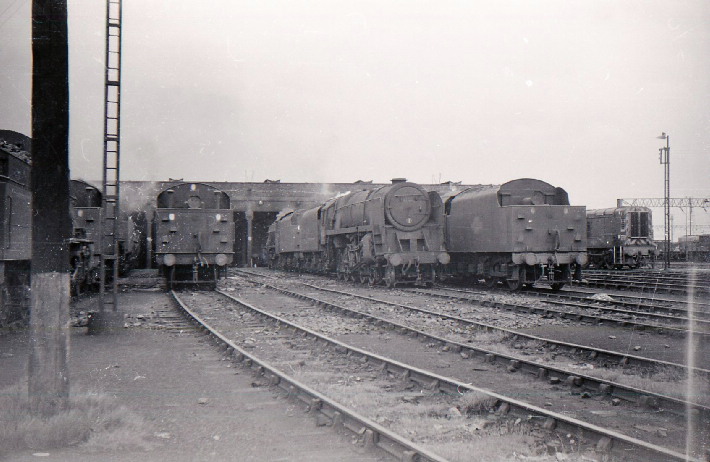
A diesel shunter and the overhead catenary point towards the future and towards the end of the steam locos at Speke within a few years the shed and steam would be history. Standing outside the shed is a Standard 9F 2-10-0 centre, an Ivatt Class 2 2-6-0 and Stanier LMS locos. Image taken in late 1960’s.
Photo from the Richard Mercer collection
Photo from the Richard Mercer collection
Opened on the 10th May 1886 by The London and North Western Railway Speke Junction was located in a strategic position for the LNWR. The shed itself had 12 covered roads which could accommodate seventy engines. The shed was located adjacent to the Liverpool to Ditton Junction line and had the Allerton to Garston Dock line located to the other side. The shed had an allocation of mainly freight locos for working out of Garston Dock and supplied locos to the various yards in the locality. Following the closure of Brunswick shed in 1961 Speke took responsibility for the provision of passenger locos for the Liverpool Central High Level to Manchester. Thus receiving a small allocation of passenger locos.
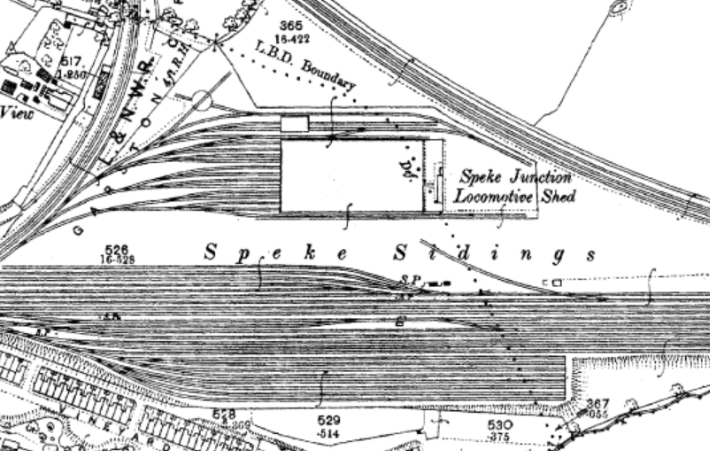
The 1893 map shows the layout of the shed as built.

The 1962 map shows the expansion of the sidings around the shed and the new connections to the main Liverpool to London line and to the Ditton to Garston line.
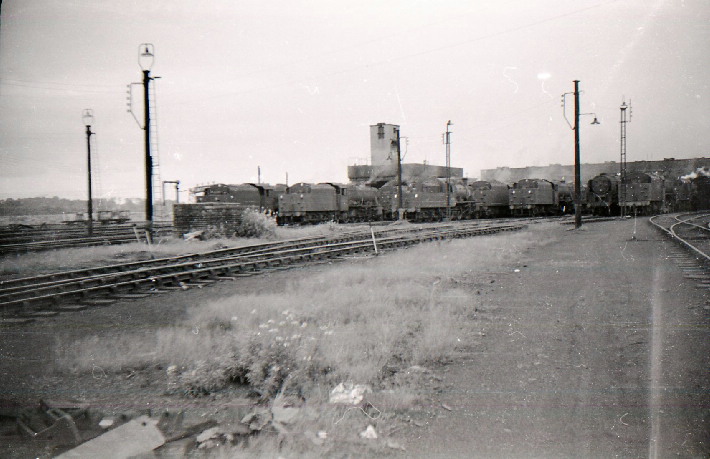
A line up of locos outside the shed which mainly consits of Stanier LMS locos with an Ivatt 2-6-0 centre and Standard 9F 2-10-0’s to the right. It was still a busy depot in the 1960’s.
Photo from the Richard Mercer collection.
Initially when opened the shed was coded 35 by the LNWR with Widnes shed a sub shed of Speke being coded 35W . It was re coded 8C by the LMS and would retain that identity until its closure by British Railways on 6th May 1968.

Standard 9F Class 2-10-0 at rest outside Speke shed the loco was transferred from 8D shed in 1965. This loco was new to stock on 18th June 1955 and was withdrawn in November 1967 from Birkenhead Mollington Street after just over 12 years of service. The loco was cut up in April 1968 by Campbells of Airdrie. 18th September 1966.
Photo by Terry Tracey
Photo by Terry Tracey
Speke was a large shed but was provided with some basic equipment by the LNWR the coaling stage was a manual type with a water tank on top. It wasn’t until 1955 under British Railways that a mechanical coaling stage was installed along with a new sand drying plant. Within a couple of years diesel tanks were to be installed as the number of diesels in the area was increasing.

A 1960’s view of the LNWR built coaling stage and water tower with a Standard 9F 2-10-0. The ash pits are located to the right.
Photo from the Richard Mercer collection.
Photo from the Richard Mercer collection.
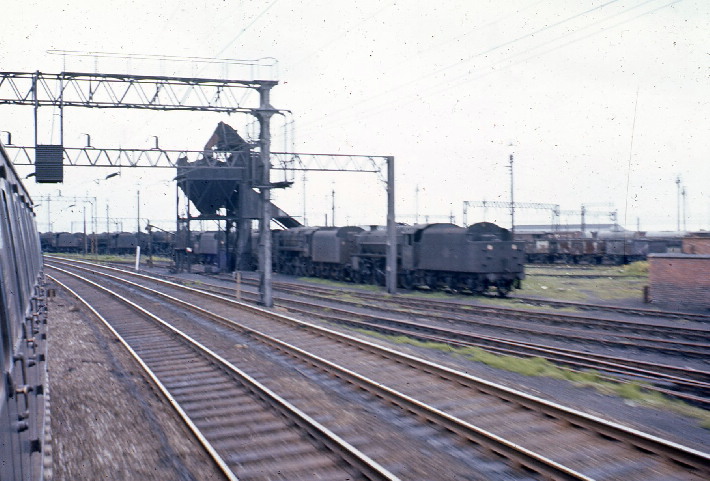
The modern coaling plant can be seen in this shot taken from a passing EMU. The locos are, from nearest, Stanier Black 5, No 45131, Standard 9Fs No 92494 and No 92249 and Stanier 8F, No 48080. June 1968.
Photo from the Richard Mercer collection.
Photo from the Richard Mercer collection.
In the run up to the Second World War the shed would accommodate around 100 engines at weekends for maintenance and servicing. The rundown of locos allocated to Speke was started in the early 1950’s with the shed having an allocation of around 49 locos and by the end of the 1950’s its allocation had fallen to 33. It is ironic to think that the shed was being improved and the fleet was being run down at the same time. By 1966 the loco allocation had increased to 57 locos.
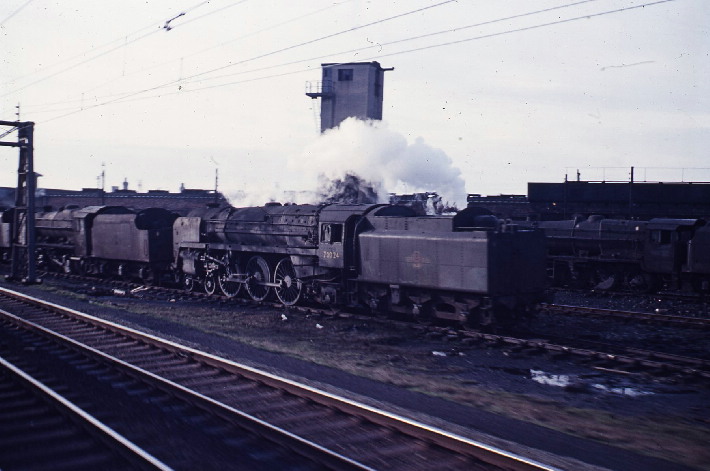
Early 1968, a B.R. Standard Class 7 Britannia 70024 Vulcan is seen from a passing train outside the shed after its withdrawl from stock. This loco was built at Crewe in October 1951 and withdrawn from traffic in December 1967 a short working life of just over 16 years.
Photo by Les Fifoot.
Photo by Les Fifoot.
An extract from the book LMR Steam Motive Power Depots shows the type of locos allocated to Speke:-
1950 – 49 locos allocated including:-
6 Stanier 2-6-0 mixed traffic
6 Hughes/Fowler 2-6-0 mixed traffic Crabs
6 LMS 3F 0-6-0 Jinties
10 Stanier 8F 2-8-0
18 ex LNWR 7F 2-8-0 Super D
1959 – 33 locos allocated including:-
9 Stanier 8F 2-8-0
14 ex LNWR 7F 2-8-0 Super D
6 LMS 3F 0-6-0 Jinties
1966 – 57 locos allocated including:-
29 Stanier Black 5
12 Stanier 8F 2-8-0
7 Ivatt class 2 2-6-0
9 Standard 9F 2-10-0 freight
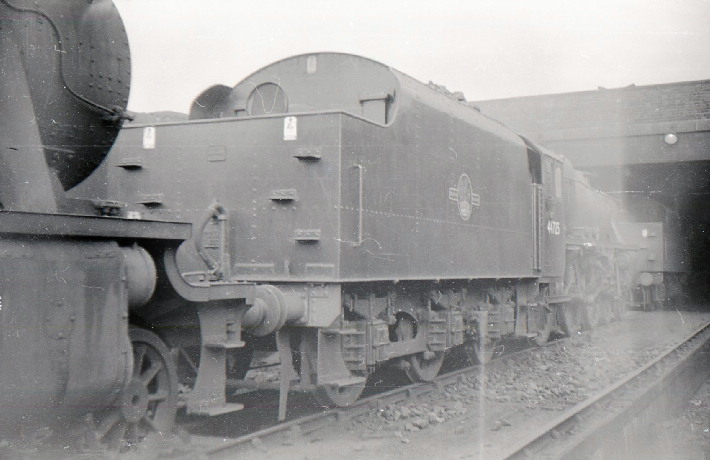
A 1960’s view, LMS Black 5 44725 is seen outside the shed.
Photo from the Richard Mercer collection.
Photo from the Richard Mercer collection.
Closure of the shed came on 6th May 1968 and the shed itself was demolished a short while later. The sidings were used for storage of withdrawn steam locos and as a diesel stabling point. A new servicing point for diesels was built nearby but this also closed on 4th October 1993.
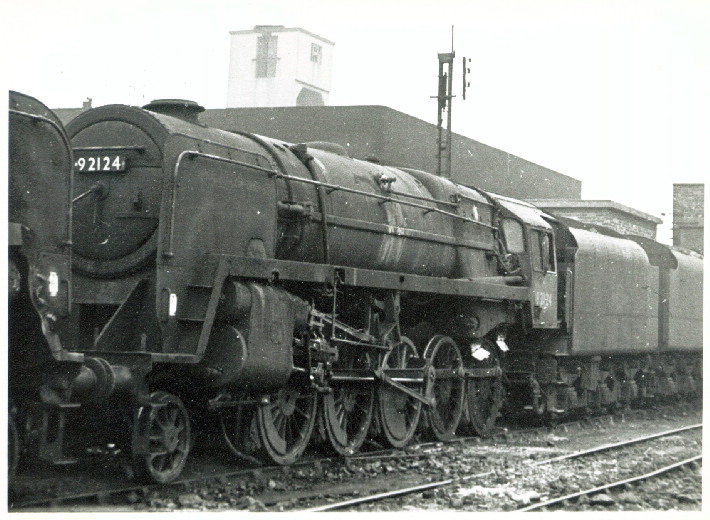
Standard ‘9F’ No 92124 stands outside Speke shed, delivered on 31st March 1957 the loco was withdrawn from Dallam shed in December 1966 after less than 10 years service. The loco was cut up by T W Ward of Kilmarnock in April 1967. 18th September 1966.
Photo by Terry Tracey.
Photo by Terry Tracey.
